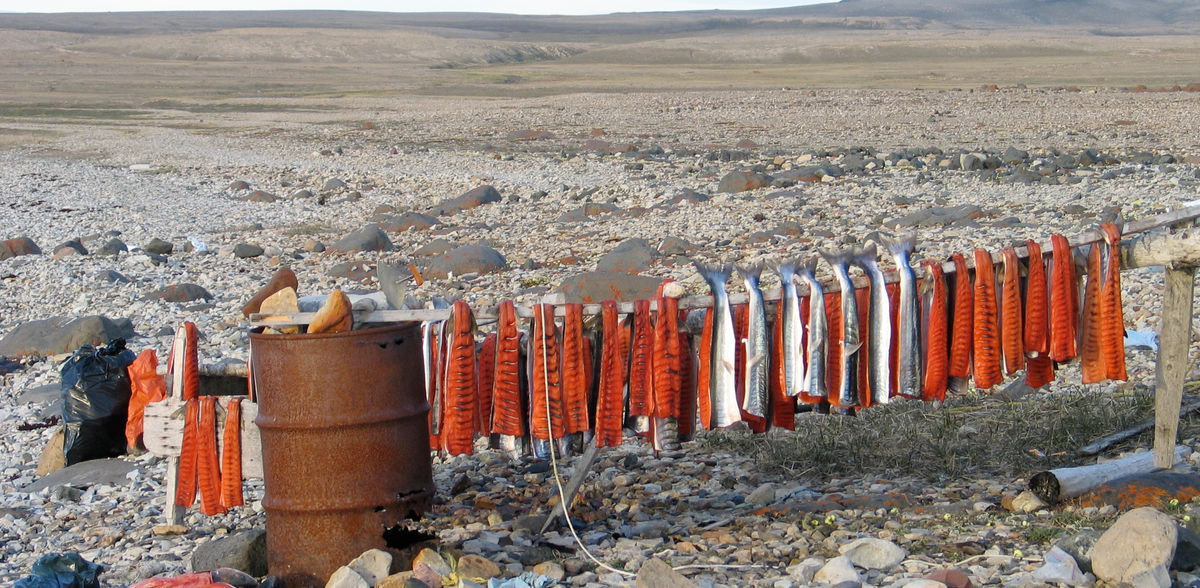Local food saves millions and CO2
Research proves economic and ecological benefits of regional food production
Focusing on local food production instead of imported substitutes can lead to significant cost and carbon savings, as data from the Inuvialuit settlement area in the Canadian Arctic shows. A new study by the Max Planck Institute for Evolutionary Anthropology and the Inuvialuit Regional Corporation shows that more than 3.1 million Canadian dollars and about half the carbon emissions can be saved annually by using local food instead of imported food. The study therefore emphasizes the importance of climate protection measures that take local food cycles into account
Local "informal" food economies are crucial for the food security and health of indigenous populations worldwide, but often remain invisible in official economic statistics. There is therefore a risk that they are overlooked when developing policies to mitigate climate change. For example, indigenous communities in the North American Arctic operate mixed economies, engaging in activities such as hunting, fishing, gathering and trapping alongside formal wage labor. The region is undergoing rapid change due to social, economic and climatic changes. In Canada, the introduction of a carbon tax is also affecting the fuel costs of local food production.
To better understand the impact of carbon taxes on Arctic food cycles, researchers from the Max Planck Institute for Evolutionary Anthropology, in collaboration with the Inuvialuit Regional Corporation, the representative body of the local indigenous population (Inuvialuit or Western Canadian Inuit), have assessed the economic and ecological importance of local food production in the Inuvialuit settlement area in the Canadian Western Arctic. To do this, the researchers used data from a regional study from 2018 and calculated the total edible weight of the food that the Inuit produce in a year, for example by hunting or fishing.
Reducing CO2 emissions requires locally adapted policies
The authors then calculated the cost of replacing these foods with imported products such as beef, pork, chicken or farmed fish. They then collected data from agriculture and transportation to estimate the carbon emissions associated with producing and transporting the substitute products to the Arctic. Finally, they used data from an Inuit study conducted by a community in the Inuvialuit settlement area (Ulukhaktok) to determine the total fuel consumption for local food production in the region.
Resulting estimates show that under plausible scenarios, replacing food produced in the Inuvialuit settlement area with imported market substitutes would cost more than 3.1 million Canadian dollars per year and emit more than 1,000 metric tons of CO2 equivalents per year. In comparison, the fuel cost portion of the local "harvest" cost is about 295,000 Canadian dollars and causes emissions of 317 to 496 tons - less than half the emissions caused by importing market substitutes. "Our results show that local food production is economically more efficient and less carbon-intensive than industrial food production - even when based on fossil fuels, as in Canada's Arctic communities," says first author Elspeth Ready, a scientist at the Max Planck Institute for Evolutionary Anthropology. "Local food production also reduces dependence on supply chains that are vulnerable to disruption from climate change."
The results of the study show that climate change mitigation measures that do not take local food production into account could undermine emissions targets and have negative impacts on the food security and health of communities in remote regions, which are subject to greater economic and logistical constraints compared to more densely populated regions. A prerequisite for successful emission reduction is therefore a policy adapted to local conditions. The statistical modeling approach developed in this study forms the basis for similar studies in other regions.
Note: This article has been translated using a computer system without human intervention. LUMITOS offers these automatic translations to present a wider range of current news. Since this article has been translated with automatic translation, it is possible that it contains errors in vocabulary, syntax or grammar. The original article in German can be found here.
Most read news
Organizations
Other news from the department science

Get the food & beverage industry in your inbox
By submitting this form you agree that LUMITOS AG will send you the newsletter(s) selected above by email. Your data will not be passed on to third parties. Your data will be stored and processed in accordance with our data protection regulations. LUMITOS may contact you by email for the purpose of advertising or market and opinion surveys. You can revoke your consent at any time without giving reasons to LUMITOS AG, Ernst-Augustin-Str. 2, 12489 Berlin, Germany or by e-mail at revoke@lumitos.com with effect for the future. In addition, each email contains a link to unsubscribe from the corresponding newsletter.































































